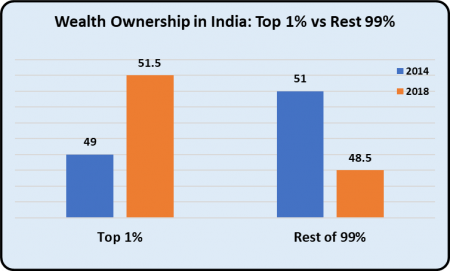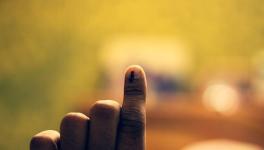In Modi’s Rule, Rich Have Become Richer, Poor are Poorer

There is much celebratory high-fiving among the elite of the country at the latest Global Wealth Report 2018 published by Credit Suisse, a Switzerland based investment bank. It says that India now has 343 dollar-millionaires, that is, those who have wealth of more than a million dollars. That’s roughly about Rs.7 crore.
But the same report also has this chilling statistic: nearly 52% of the total wealth of the country is now controlled by the top 1% of the population while the remaining 99% have to be content with just over 48% of the wealth.
Strikingly, this enormous imbalance in wealth distribution – otherwise known as inequality – has worsened since the BJP government led by Narendra Modi came to power in 2014. In that year, the shares were reverse with the top 1% owning about 49% and the rest 99% owning 51% of the wealth, as per the 2014 Credit Suisse report.

In case you think the difference is not much, here is another way of looking at it: while dollar-millionaires increased from 0.02% of the population to 0.04% under Modi’s rule, the number of adults owning wealth less than Rs.7 lakh ($10,000) decreased from 94.5% to 90.8% of the population. As a result, there are still over 77 crore adults who own less than Rs.7 lakh of wealth, out of a total number of adults estimated by the report at about 85 crore.
What this report shows is that a very very small minority of adults – a handful, really – have gained enormously in the past five years while the rest of the people, especially the poor, have become poorer or at best remained as they were.
This fact is also reflected in a measure of inequality called the Gini coefficient. India’s Gini coefficient has worsened from 81.4% in 2014 to 85.4% in 2018. Note that a Gini coefficient of 100% represents ‘perfect’ inequality while 0 represents no inequality.
All these numbers relate to wealth not income. It represents all the wealth that the individual may have accumulated or inherited over the years. Wealth may consist of financial assets (like shares and bonds), non-financial assets (land, house) or debt. Wealth is related to income in the sense that if you have high income, you will be accumulating wealth because you cannot spend all that you earn. Conversely, a poor person will spend most of his or her income on current consumption – food, rent, transport, etc. – and end up not adding any wealth. Credit Suisse does not track incomes in this report.
Incomes are tracked by another database called the World Inequality Database (WID), which recently reported that, in India, average inflation adjusted income of the bottom 50% of the population was just Rs.45,000 per year per adult compared with Rs.33 lakh per year per adult for the top 1% of the population.
This staggering chasm of incomes between the haves and the havenots in India is complementary to the similar chasm in wealth. The latter is perpetuated by the former – in fact, wealth inequality is growing because of this income inequality.
These revelations decisively remove any doubts about the way the Modi government has managed the country – it has benefitted the corporate entities and big property owners while squeezing the poor mercilessly. It is possible that some sections of the middle class may have gained some income increments or their wealth may have increased because of property prices or stock market gambling. But the bitter truth remains that Modi has betrayed his biggest, most lucrative promise – that of achhe din (good days) coming soon.
Get the latest reports & analysis with people's perspective on Protests, movements & deep analytical videos, discussions of the current affairs in your Telegram app. Subscribe to NewsClick's Telegram channel & get Real-Time updates on stories, as they get published on our website.
























